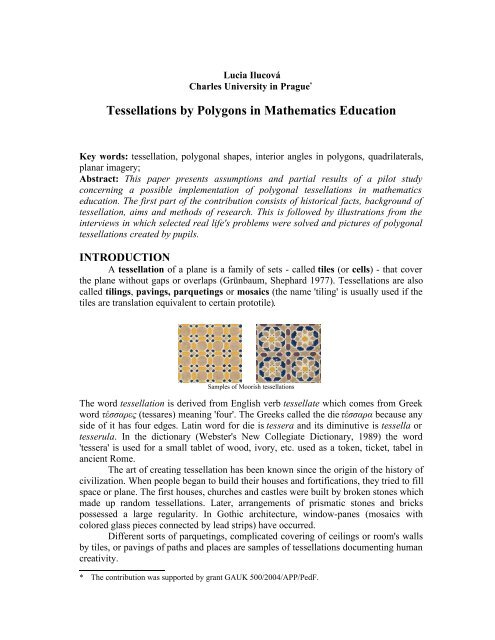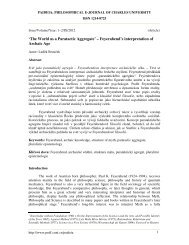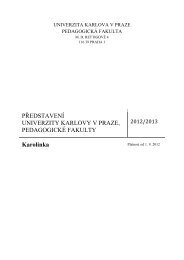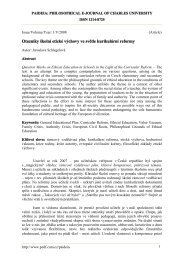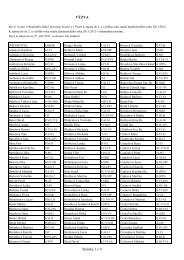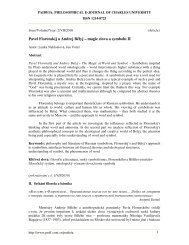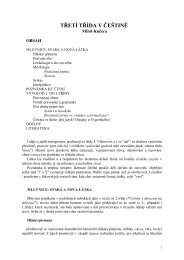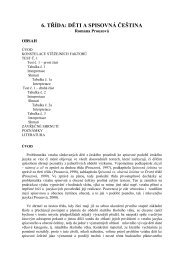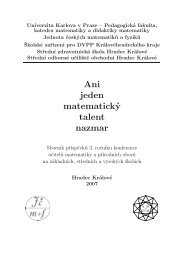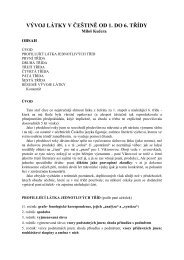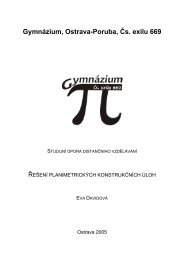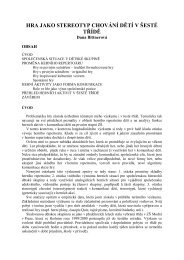Tessellations by Polygons in Mathematics Education
Tessellations by Polygons in Mathematics Education
Tessellations by Polygons in Mathematics Education
You also want an ePaper? Increase the reach of your titles
YUMPU automatically turns print PDFs into web optimized ePapers that Google loves.
Lucia Ilucová<br />
Charles University <strong>in</strong> Prague *<br />
<strong>Tessellations</strong> <strong>by</strong> <strong>Polygons</strong> <strong>in</strong> <strong>Mathematics</strong> <strong>Education</strong><br />
Key words: tessellation, polygonal shapes, <strong>in</strong>terior angles <strong>in</strong> polygons, quadrilaterals,<br />
planar imagery;<br />
Abstract: This paper presents assumptions and partial results of a pilot study<br />
concern<strong>in</strong>g a possible implementation of polygonal tessellations <strong>in</strong> mathematics<br />
education. The first part of the contribution consists of historical facts, background of<br />
tessellation, aims and methods of research. This is followed <strong>by</strong> illustrations from the<br />
<strong>in</strong>terviews <strong>in</strong> which selected real life's problems were solved and pictures of polygonal<br />
tessellations created <strong>by</strong> pupils.<br />
INTRODUCTION<br />
A tessellation of a plane is a family of sets - called tiles (or cells) - that cover<br />
the plane without gaps or overlaps (Grünbaum, Shephard 1977). <strong>Tessellations</strong> are also<br />
called til<strong>in</strong>gs, pav<strong>in</strong>gs, parquet<strong>in</strong>gs or mosaics (the name 'til<strong>in</strong>g' is usually used if the<br />
tiles are translation equivalent to certa<strong>in</strong> prototile).<br />
Samples of Moorish tessellations<br />
The word tessellation is derived from English verb tessellate which comes from Greek<br />
word τέσσαρες (tessares) mean<strong>in</strong>g 'four'. The Greeks called the die τέσσαρα because any<br />
side of it has four edges. Lat<strong>in</strong> word for die is tessera and its dim<strong>in</strong>utive is tessella or<br />
tesserula. In the dictionary (Webster's New Collegiate Dictionary, 1989) the word<br />
'tessera' is used for a small tablet of wood, ivory, etc. used as a token, ticket, tabel <strong>in</strong><br />
ancient Rome.<br />
The art of creat<strong>in</strong>g tessellation has been known s<strong>in</strong>ce the orig<strong>in</strong> of the history of<br />
civilization. When people began to build their houses and fortifications, they tried to fill<br />
space or plane. The first houses, churches and castles were built <strong>by</strong> broken stones which<br />
made up random tessellations. Later, arrangements of prismatic stones and bricks<br />
possessed a large regularity. In Gothic architecture, w<strong>in</strong>dow-panes (mosaics with<br />
colored glass pieces connected <strong>by</strong> lead strips) have occurred.<br />
Different sorts of parquet<strong>in</strong>gs, complicated cover<strong>in</strong>g of ceil<strong>in</strong>gs or room's walls<br />
<strong>by</strong> tiles, or pav<strong>in</strong>gs of paths and places are samples of tessellations document<strong>in</strong>g human<br />
creativity.<br />
* The contribution was supported <strong>by</strong> grant GAUK 500/2004/APP/PedF.
Every known human society made use of til<strong>in</strong>gs and patterns <strong>in</strong> some form or<br />
another. People's portraits and nature's scenes often occurred on <strong>in</strong>tricate mosaics from<br />
Mediterranean region. On the other hand, Islamic religion strictly prohibits such<br />
depictions of humans and animals which might result <strong>in</strong> idol-worship, so that Moors<br />
and Arabs created art utiliz<strong>in</strong>g a number of primary forms: geometric, arabesque, floral<br />
and calligraphic. Moorish architecture <strong>in</strong> Spa<strong>in</strong> and Islamic culture <strong>in</strong> the Middle East<br />
have shown grateful samples of planar tessellations with rich ornaments. The palace<br />
Alhambra <strong>in</strong> Spanish Granada is one of the best-known and most-preserved relic of the<br />
Islamic civilization on Pyrenees pen<strong>in</strong>sula.<br />
Planar tessellations occur also <strong>in</strong> the modern art of the twentieth century, namely<br />
<strong>in</strong> creations of Dutch artists M. C. Escher (1898-1972) and P. Mondrian (1872-1944). In<br />
fact, Escher was fasc<strong>in</strong>ated and deeply <strong>in</strong>spired <strong>by</strong> Alhambra's mosaics and later he used<br />
some motifs derived from them <strong>in</strong> his pr<strong>in</strong>ts. He used mathematical imag<strong>in</strong>ation as tool<br />
for his graphics, he often filled plane <strong>by</strong> figures of people and animals (Day and Night,<br />
1938) or connected fill<strong>in</strong>g of plane and space (The Reptiles, 1943). He said about his<br />
work (Ranucci and Teeters, 1977): ”Although I am absolutely without tra<strong>in</strong><strong>in</strong>g or<br />
knowledge <strong>in</strong> the exact sciences, I often seem to have more <strong>in</strong> common with<br />
mathematicians than with my fellow artists.” Mondrian often used nets and grids to<br />
depict reality. In this way he tried to avoid differences between figure and background,<br />
between mass and antimass (Composition with net 8, Chessboard with dark colors,<br />
1919; Broadway Boogie Woogie, 1942-1943) (Gold<strong>in</strong>g, 2000).<br />
The first deep mathematical study of tessellations, Harmonices Mundi, was<br />
written <strong>in</strong> 1619 <strong>by</strong> Johannes Kepler. He described geometric properties of planar<br />
tessellations <strong>by</strong> regular polygons. However, his contribution to astronomy was so<br />
monumental that his geometric <strong>in</strong>vestigations were largely forgotten for almost 300<br />
years.<br />
In 1975, papers about planar til<strong>in</strong>g <strong>by</strong> pentagons were published <strong>in</strong> the Scientific<br />
American. It has been an <strong>in</strong>terest<strong>in</strong>g problem for mathematicians because there has not<br />
been any rule for their general construction. Marjorie Rice, a San Diego housewife with<br />
no formal education <strong>in</strong> mathematics but with enormous enthusiasm, has started to f<strong>in</strong>d<br />
out new and until unknown types of pentagons til<strong>in</strong>g the plane.<br />
Recently B. Grünbaum and G. C. Shephard elaborated the detailed theory of<br />
planar tessellations and symmetries of the patterns (e.g. Grünbaum and Shephard,<br />
1987).<br />
MATHEMATICAL BACKGROUND<br />
Some part of the mathematical theory concern<strong>in</strong>g tessellations is elementary,<br />
but it conta<strong>in</strong>s a rich supply of <strong>in</strong>terest<strong>in</strong>g and surpris<strong>in</strong>g problems which can be solved<br />
at various age levels of pupils. In this area, we focus on the problem of some types of<br />
the planar tessellations created <strong>by</strong> polygons.<br />
Let us consider three follow<strong>in</strong>g mathematical statements important for this<br />
research (the first one is a part of mathematics curriculum and is given without proof<br />
here):<br />
Statement 1: The sum of all <strong>in</strong>terior angles <strong>in</strong> every quadrilateral is equal to 360°.<br />
Statement 2: Every quadrilateral tessellates the plane <strong>by</strong> itself.
(The existence of the tessellation built up of the arbitrary identical quadrilateral tiles is a<br />
content of this statement.)<br />
Proof:<br />
Let α, β, γ, δ are the <strong>in</strong>terior angles of a general quadrilateral. Their sum is equal to<br />
360˚. Every quadrilateral can be arranged <strong>in</strong> the tessellation as shown <strong>in</strong> the picture:<br />
Four quadrilaterals meet at each vertex and the correspond<strong>in</strong>g <strong>in</strong>terior angles form<br />
together the angle of 360˚, so that there are no gaps and overlaps.<br />
(The same statement holds for the triangles; only some specific types of other polygons<br />
tessellate the plane <strong>by</strong> themselves.)<br />
Statement 3: Only three regular polygons tessellate the plane <strong>by</strong> themselves: triangles,<br />
squares and hexagons.<br />
Proof (for the equilateral triangles):<br />
All <strong>in</strong>terior angle of equilateral triangle is equal to 60˚. Six triangles meet at each vertex<br />
and six correspond<strong>in</strong>g <strong>in</strong>terior angles form the angle of 360˚ (= 6. 60˚). So that there are<br />
no gaps and overlaps.<br />
PROPOSED RESEARCH QUESTIONS<br />
I worked twice with my pupils (14/15 years, 15/16 years) on problems<br />
concern<strong>in</strong>g tessellations (<strong>in</strong> 2002 and 2003). Their groups were large <strong>in</strong> the both cases<br />
and, moreover, several other problems have to be covered <strong>in</strong> the lessons, so that there<br />
was not sufficient time for a more detailed exam<strong>in</strong>ation. However, this experience could<br />
serve as a basis for the present qualitative experiment.<br />
We focus <strong>in</strong> the research on detect<strong>in</strong>g some cognitive and <strong>in</strong>teractive phenomena<br />
which can be divided <strong>in</strong>to five groups. They can be characterised as the answers to the<br />
follow<strong>in</strong>g questions:<br />
Cognitive phenomena<br />
1. Means of expressions and bil<strong>in</strong>gualism<br />
What verbal and nonverbal communication tools do children use?<br />
How successful is the communication <strong>in</strong> pairs and between pairs and experimenter?<br />
The <strong>in</strong>terviews were held <strong>in</strong> Czech (solvers) and Slovak (experimenter); how do<br />
children manage to overcome the bil<strong>in</strong>gualism? (These languages are closed enough,<br />
but there are some differences, e.g. <strong>in</strong> the term<strong>in</strong>ology of quadrilaterals: square -<br />
čtverec/ štvorec, rectangle - obdélník/ obdĺžnik, general - obecný/ všeobecný,...)<br />
2. Planar imagery<br />
There is much <strong>in</strong>formation about the imagery and the spatial imagery available, but the
concept of 'planar imagery' is not much known and used. In our research we try to f<strong>in</strong>d<br />
out the th<strong>in</strong>gs characterize this phenomenon.<br />
The planar imagery could be def<strong>in</strong>ed as “... the basic psychic function, which is<br />
important for the psychic visualization of the planar events that are not actual, <strong>in</strong> the<br />
constructive and reconstructive mean<strong>in</strong>gs ...”.<br />
(accord<strong>in</strong>g Půlpán et al., 1992)<br />
Which tools do children choose to solve the problems?<br />
What strategy do they use - what do they do? Do they improve their strategy <strong>by</strong><br />
preced<strong>in</strong>g experience? Do they improve their strategy if they are unsuccessful?<br />
How many different arrangements of tiles do they manage to f<strong>in</strong>d?<br />
3. Mathematical content<br />
Which mathematical concepts do children use? (the term<strong>in</strong>ology of the quadrilaterals,<br />
the properties of figures and angles, ...)<br />
Do they understand them?<br />
Do they f<strong>in</strong>d out why every quadrilateral can be used as tile?<br />
4. Proofs and justify<strong>in</strong>g<br />
Do children justify their answers?<br />
Do they feel the need of a proof?<br />
How do they prove their statements?<br />
Interactive phenomena<br />
Interpersonal relations<br />
How do children work together?<br />
What are their mutual relations as partners <strong>in</strong> look<strong>in</strong>g for the solution of the problem?<br />
How do they react when they are not successful and are told that the problem does have<br />
a solution?<br />
The po<strong>in</strong>ts 2 and 4 seem to be the most important <strong>in</strong> this research.<br />
METHODOLOGY<br />
The quadrilaterals have been chosen as tiles because some of such tessellations<br />
are the most frequently occurr<strong>in</strong>g <strong>in</strong> the real life (square tiles, rectangular parquets) and<br />
the mathematical solution concern<strong>in</strong>g them can be easy to f<strong>in</strong>d for the majority of<br />
children. Five used types of quadrilaterals are those which are the most frequently<br />
handled <strong>in</strong> the school geometry, only the sixth one (a general nonconvex quadrilateral)<br />
is uncommon. (Operations with triangles and regular types of other polygons are madeup<br />
on similar pr<strong>in</strong>ciples.)<br />
In problems, manipulat<strong>in</strong>g with models of quadrilaterals proceeds from the the<br />
simplest shape - square - to general convex and nonconvex shapes. Thus pupils can<br />
repeat hierarchy of the quadrilaterals or it can be the opportunity to beg<strong>in</strong> with it (dur<strong>in</strong>g<br />
solv<strong>in</strong>g problems children also observed the properties of the quadrilateral figures -<br />
parallelism of the opposite sides, length of the sides, <strong>in</strong>terior angles, ...).
Semi-structured <strong>in</strong>terviews with the pairs of pupils from the age of 13 to 16<br />
years were carried out separately. Interviews took time from 17 to 27 m<strong>in</strong>utes and took<br />
place <strong>in</strong> classroom after the lessons. If the children were communicative they were not<br />
<strong>in</strong>terrupted, otherwise supplementary questions were posed (why did you do so? can<br />
you expla<strong>in</strong> it? ...).<br />
The tools for solv<strong>in</strong>g the problems were set up on the table and none of them<br />
were preferred (the children were free to choose convenient tools for their work). The<br />
tools can be divided <strong>in</strong>to two groups: the ma<strong>in</strong> tools (square, colored and white papers<br />
of the format A4, paper models of quadrilaterals, pencils) and the supplementary tools<br />
(scissors, ruler, pens); “the build<strong>in</strong>g set” is my work<strong>in</strong>g name for the paper models of<br />
quadrilaterals. It consisted of 10 - 14 figures for every chosen types of the quadrilaterals<br />
(square, rectangle, parallelogram, trapezium, general convex and nonconvex<br />
quadrilateral) and was made of the cardboard <strong>by</strong> the experimenter before the <strong>in</strong>terviews.<br />
For the subsequent analysis, the <strong>in</strong>terviews have to be recorded; video camera and<br />
dictaphone are unavoidable.<br />
quadrilaterals conta<strong>in</strong>ed <strong>in</strong> 'the build<strong>in</strong>g set'<br />
Required problems are formulated as the questions concern<strong>in</strong>g the real life that can be<br />
answered <strong>by</strong> YES-NO and substantiated e. g. <strong>by</strong> a picture or a mosaic created <strong>by</strong> the<br />
paper quadrilaterals.<br />
Problems:<br />
1. When til<strong>in</strong>g the wall <strong>in</strong> the bathroom, can we use identical tiles of a square shape?*<br />
2. Can we use identical parquets of a rectangular shape to cover the floor?*<br />
3. Can we use identical parquets of a parallelogram shape?*<br />
4. Can we use identical parquets of a trapezoid shape?*<br />
5. Can we use identical parquets of such a shape?* (a general convex quadrilateral)<br />
6. Can we use identical parquets of such a shape?* (a general nonconvex quadrilateral)<br />
(The concepts 'convex' and 'nonconvex' are unknown for pupils of such age levels, so<br />
these quadrilaterals are po<strong>in</strong>ted them.)<br />
*The first four problems have several solutions, hence the children were asked: Is the<br />
proposed til<strong>in</strong>g the unique possible one? Can these tiles (parquets) be arranged<br />
otherwise?<br />
After solv<strong>in</strong>g these particular problems, the pupils were asked the follow<strong>in</strong>g<br />
questions:<br />
Is it possible to use identical parquets of an arbitrary quadrilateral shape?<br />
If YES, why?<br />
(Did you exam<strong>in</strong>e with all possible quadrilateral shapes?)<br />
If NO, f<strong>in</strong>d out parquets of such a quadrilateral shape which we cannot use to cover<br />
the floor.
The first question concerns the square tiles <strong>in</strong> the bathroom, the other ones concern<br />
the parquets; why are the problems formulated that way?<br />
After clos<strong>in</strong>g the <strong>in</strong>terviews, the pupils were asked to fill a questionnaire and to<br />
do a homework. Questions concern their mathematical efforts, deal<strong>in</strong>gs with their<br />
cooperative partner and relation to the subject of mathematics. The answers (especially<br />
questions 3. and 4., see below) are subsequently analysed. The homework concerns<br />
tessellations <strong>by</strong> other polygons (triangle, pentagon, hexagon, ...). The observation<br />
dur<strong>in</strong>g the <strong>in</strong>terview could be slightly subjective, hence it is not regarded as the most<br />
important (but it can help to expla<strong>in</strong> some phenomena, e.g. observed nervousness of<br />
children could expla<strong>in</strong> their approach to the problem). The basic <strong>in</strong>formation about<br />
pupils was acquired from the teacher. The children's answers compared mutually and<br />
with our assumed (correct) answers.<br />
Questionnaire<br />
1. What is the mathematics mark on your school report?<br />
Are you satisfied with your results <strong>in</strong> mathematics or do you want to improve?<br />
2. How do you get along with a boy/girl that you solved problems with?<br />
Are you good friends?<br />
3. Did you like the solved problems? Are they different from those ones solved <strong>in</strong><br />
mathematics lessons? What is the difference?<br />
4. Which quadrilateral figure does seem to be the most <strong>in</strong>terest<strong>in</strong>g for you and why?<br />
Homework<br />
1. Have you got the tiled bathroom or kitchen at home? Have you got the parquets at<br />
home? If yes, draw them.<br />
2.Th<strong>in</strong>k about parquets of another shapes, e.g. triangular, pentagonal,<br />
hexagonal,...and draw such parquet<strong>in</strong>gs.<br />
The result<strong>in</strong>g draw<strong>in</strong>gs of the tessellations <strong>by</strong> the polygons different from the<br />
quadrilaterals will be analysed <strong>by</strong> the method of the case study. mohli<br />
(In my previous experiences pupils created designs of the tessellations for wall, path or<br />
floor til<strong>in</strong>gs. They used mostly tessellations <strong>by</strong> very complicated shapes which could<br />
not be simply justified mathematically.)<br />
PARTIAL RESULTS<br />
Five pairs of children were <strong>in</strong>terviewed. Their names, ages and simple<br />
characteristics of pairs are <strong>in</strong> the follow<strong>in</strong>g table. Children cooperated very well <strong>in</strong><br />
pairs; I suppose that teachers chose friends for pairs (it was not my decision).<br />
Names<br />
Michael (M)<br />
Petr (P1)<br />
Kristína (K)<br />
Tereza (T)<br />
Age and<br />
sex<br />
Date of<br />
experiment<br />
13, M February 2004<br />
13, F February 2004<br />
Comments (experimenter's observation)<br />
easy to work with, very communicative pair<br />
easy to work with, but they were a little bit bored <strong>by</strong> this activity<br />
and they laughed often
Names<br />
Lukáš (L)<br />
Jan (J)<br />
Hana (H)<br />
Veronika (V)<br />
Gáb<strong>in</strong>a (G)<br />
Petr (P2)<br />
Age and<br />
sex<br />
Date of<br />
experiment<br />
Comments (experimenter's observation)<br />
16,15, M May 2004<br />
they were very nervous (I suppose, because of not know<strong>in</strong>g me )<br />
15, F May 2004<br />
even when H was the ma<strong>in</strong> verbal communicator of pair, V was<br />
not the passive solver only<br />
14, F, M May 2004<br />
easy to work with, the both children reacted quickly to my<br />
questions<br />
Illustrations from the <strong>in</strong>terviews<br />
From the transcriptions of the <strong>in</strong>terviews, the follow<strong>in</strong>g extracts were chosen to<br />
illustrate the children's th<strong>in</strong>k<strong>in</strong>g and solv<strong>in</strong>g process when answer<strong>in</strong>g two selected<br />
questions.<br />
The question Is it possible to use identical parquets of an arbitrary quadrilateral<br />
shape? was answered as follows:<br />
M: Yes, it could be, but it goes from difficult to even more difficult.<br />
P1: Sure, it would be possible. But it would be very complicated.<br />
...<br />
P1: So that if you have these angles, so you can put them together.<br />
(This sentence seems to be the closest to the formal solution.)<br />
J: ...I don't know...(long pause)... if it were perhaps some regular one... perhaps<br />
parallelograms fitt<strong>in</strong>g together... but with some arbitrary quadrilateral, then it<br />
wouldn't go... it wouldn't fit together.<br />
H: Yes, I th<strong>in</strong>k so. Except this one (she po<strong>in</strong>ts to the unsuccessful tessellation <strong>by</strong><br />
nonconvex quadrilateral)... so that... no... (they laugh).<br />
V: Just those ones which we managed.<br />
G: No.<br />
The question The first question concerns the square tiles <strong>in</strong> the bathroom, the<br />
other problems concern the parquets; suppose, why do I formulate problems that<br />
way? was answered as follows:<br />
K: Because... In fact... Because this one (the tessellation <strong>by</strong> nonconvex<br />
quadrilateral) wouldn't go for the wall rather like parquets.<br />
T: Rather it would be all bad useable.<br />
K: But it would be strange to look at.<br />
T: ... Maybe it would be bad to handle.<br />
K: It's also complicated and these (the tessellation <strong>by</strong> squares) are so simple.<br />
L: That is... that walls are usually tiled <strong>by</strong> square tiles. That it isn't so difficult to<br />
arrange, to f<strong>in</strong>d that comb<strong>in</strong>ation and the square has all sides of the same length.<br />
H:There are usually these tiles <strong>in</strong> the bathroom... the square ones. It would look
very strange if there were these ones (she po<strong>in</strong>ts to the nonconvex quadrilateral's<br />
tessellation).<br />
V: It's the simplest way, isn't it?<br />
G: Because these tiles are ma<strong>in</strong>ly the squares or of the rectangular shape...<br />
P2: I haven't seen such tiles as yet (he po<strong>in</strong>ts to the nonconvex quadrilateral<br />
tessellation).<br />
G: Neither me.<br />
...<br />
G: They seems to me (she th<strong>in</strong>ks about) ...<br />
P2: ...so kitscher.<br />
Notes on the course of the <strong>in</strong>terviews<br />
My <strong>in</strong>terest <strong>in</strong> mathematics was known to children so that they were rather<br />
surprised <strong>by</strong> my first posed question. (Perhaps they expected “someth<strong>in</strong>g more<br />
mathematical”.) Also further problems sometimes evoked pupils' laugh<strong>in</strong>g. But except<br />
the pair T+K, the other children wrote or told that they were <strong>in</strong>terested <strong>in</strong> the required<br />
problems.<br />
All pairs were communicative. Even when some of them were little nervous at<br />
the beg<strong>in</strong>n<strong>in</strong>g of the <strong>in</strong>terview, there were no problems to work with them. Sometimes<br />
children communicated between themselves <strong>in</strong> a low voice or <strong>by</strong> the “eye contacts”,<br />
they also used hands as a complementary communicative tool. There was no problem<br />
with the bil<strong>in</strong>gualism.<br />
The answers to the required problems can be substantiated <strong>by</strong> means of us<strong>in</strong>g<br />
'the build<strong>in</strong>g set' (the paper models) or draw<strong>in</strong>g the correspond<strong>in</strong>g til<strong>in</strong>gs. Only one pair<br />
(L+J) solved the first three problems <strong>by</strong> draw<strong>in</strong>g the tessellations (and tessellation <strong>by</strong><br />
trapezoid figures was too difficult to draw for them), the other pairs used the paper<br />
models from the beg<strong>in</strong>n<strong>in</strong>g of the <strong>in</strong>terview; only the pair M+P1 used also the scissors<br />
for some additional problem emerg<strong>in</strong>g dur<strong>in</strong>g the <strong>in</strong>terview. All pairs found at least two<br />
tessellation arrangements for squares, rectangles and parallelograms (M+P1 was the<br />
most successful pair). In the solutions of pairs M+P1 and T+K there also ocurred the<br />
us<strong>in</strong>g of the previous solutions (rectangle: “it is like the square, but there are two<br />
jo<strong>in</strong>ed squares now”; rhomboid: “it is similar like <strong>by</strong> rectangles”; trapezoid: “when we<br />
put them like that, then a parallelogram is formed there” ), the other pairs tiled<br />
randomly (<strong>by</strong> my feel<strong>in</strong>g). Handl<strong>in</strong>g the general convex and nonconvex quadrilaterals<br />
was the most difficult for children. Three pairs were not successful with one of them;<br />
after be<strong>in</strong>g told that the problem can be solved, they tried to f<strong>in</strong>d it and be<strong>in</strong>g aga<strong>in</strong><br />
unsuccessful, they at least admitted “...maybe it could, but we would need more time to<br />
th<strong>in</strong>k about the arrangement...”. The pair G+P2 was successful with a general<br />
nonconvex quadrilateral, but not with a general convex one; they found the pr<strong>in</strong>ciple<br />
'the shorter sides together, the longer sides together', but they were not be able to use it<br />
for the general convex type aga<strong>in</strong>. Seven children answered the question Which<br />
quadrilateral figure does seem to be the most <strong>in</strong>terest<strong>in</strong>g and why? that just a general<br />
nonconvex quadrilateral is <strong>in</strong>terest<strong>in</strong>g (or “strange”) because e.g. “it is absolutely<br />
someth<strong>in</strong>g else like for example the square”. (Manipulat<strong>in</strong>g with the nonconvex<br />
quadrilaterals was very <strong>in</strong>terest<strong>in</strong>g process. It is not a “common” quadrilateral occurr<strong>in</strong>g
<strong>in</strong> mathematical lessons. Some people have to count the number of its sides to persuade<br />
themselves that this figure is really a quadrilateral.)<br />
Three pairs used right the term<strong>in</strong>ology of the quadrilaterals (their names were<br />
the cont<strong>in</strong>uous component of their slang language), two youngest pairs (K+T and<br />
M+P1) made some mistakes. But only these pairs <strong>in</strong>tuitively found out why every<br />
quadrilateral tessellates the plane <strong>by</strong> itself: the underl<strong>in</strong>ed sentence from <strong>in</strong>terview<br />
(M+P1) “So that if you have these angles, so you can put them together.” and (T+K)<br />
“If we put the shorter sides together and the longer ones, too...and we get the circle.”.<br />
The proofs were absent <strong>in</strong> these <strong>in</strong>terviews, there was not the need of them<br />
because children thought they worked with all possible quadrilateral shapes (“and the<br />
other quadrilaterals look like as well as those ones”).<br />
<strong>Tessellations</strong> created <strong>by</strong> pupils<br />
This part will be the further subject of a research <strong>in</strong> which I shall try to answer<br />
the follow<strong>in</strong>g questions:<br />
What polygonal shapes and their arrangements do they use?<br />
Why do they use these polygons?<br />
What tool do they use to draw it?<br />
Were they <strong>in</strong>spired <strong>by</strong> typical real life's tessellation (e.g. usual parquet<strong>in</strong>gs,<br />
honeycomb, ...)?<br />
I worked with five pairs of children, but the draw<strong>in</strong>gs of the tessellations were<br />
turned <strong>in</strong> only from three pairs. Two girls (T+K) worked together, the other children<br />
prepared their draw<strong>in</strong>gs separately. This part of the homework was based on the<br />
work<strong>in</strong>g with the polygons different from the quadrilaterals. In spite of this fact P1 drew<br />
the tessellation <strong>by</strong> the nonconvex quadrilaterals. The simplest polygon, triangle,<br />
occurred only <strong>in</strong> one case (H). Children used to draw black pens and black pencils. K+T<br />
drew the tessellations on the square paper, M and P1 on the l<strong>in</strong>e paper and H on the<br />
white paper.<br />
Hana's tessellations
Kristína and Tereza's tessellations<br />
Michael's tessellations<br />
Petr's (P1) tessellations<br />
CONCLUSIONS<br />
The exam<strong>in</strong>ed topic is very close to the real life (architecture, art) and its<br />
pr<strong>in</strong>ciples are based on mathematics. Dur<strong>in</strong>g the <strong>in</strong>terviews children dealed with<br />
someth<strong>in</strong>g absolutely common to them (square tiles, rectangular parquets) but they had<br />
not thought about it before. They are not used to use mathematics as a tool to solve the<br />
real life's problems yet.<br />
Children were <strong>in</strong>terested <strong>in</strong> the required problems, they answered the questions<br />
Did you like the solved problems? Are they different from those ones solved <strong>in</strong><br />
<strong>Mathematics</strong> lessons? What is the difference? as follows:<br />
I liked the problems, ma<strong>in</strong>ly because statements have to be defendanded and to be<br />
proved .<br />
We don't do such problems, only sometimes we comb<strong>in</strong>e and glue the paper figures.<br />
Yes, they were <strong>in</strong>terest<strong>in</strong>g, perhaps we rather count <strong>in</strong> mathematics lessons.<br />
The problems were different from usual mathematical lessons. We count more than play<br />
with patterns on the lessons.<br />
<strong>Mathematics</strong> of bathroom's til<strong>in</strong>gs or floor's parquet<strong>in</strong>gs is somewhat
unexpected even for the adults, too. There was held a didactic program for teachers of<br />
mathematics <strong>in</strong> February 2004 at our faculty called Two Days with Didactics of<br />
<strong>Mathematics</strong>. I contributed to it <strong>by</strong> a workshop entitled Parquet<strong>in</strong>gs, til<strong>in</strong>gs, mosaics<br />
and geometry. Some participants of this workshop solved the same problems similar<br />
like the children - randomly. After solv<strong>in</strong>g the same problems, they were asked to<br />
answer the question “is it possible to use identical parquets of an arbitrary<br />
quadrilateral shape?” and they were obliged to use the words common for the<br />
children taught <strong>by</strong> them. I had already heard similar answers from the pupils <strong>in</strong> my<br />
previous experiences:<br />
It can, because we tested all “sorts” of quadrilaterals.<br />
It can, because some pupils were successful <strong>in</strong> the class (I wasn't) and the teacher<br />
praised them.<br />
Yes, it can, because I've been successful until now.<br />
It seems that even when of wide practical application the problem of<br />
tessellations is troublesome. In general, perhaps because of its complete absence <strong>in</strong><br />
mathematical curriculum.<br />
REFERENCES<br />
1. GOLDING, J. (2000) Paths to the Absolute (Pr<strong>in</strong>ceton University Press).<br />
2. GRÜNBAUM, B. & SHEPHARD, G. C. (1987) Til<strong>in</strong>gs and Patterns (New York, W. H. Freeman<br />
and Company).<br />
3. GRÜNBAUM, B. & SHEPHARD, G. C. (1977) Til<strong>in</strong>gs <strong>by</strong> regular polygons, <strong>Mathematics</strong><br />
Magaz<strong>in</strong>e, 5, pp. 227-245.<br />
4. RANUCCI, E. R. & TEETERS, J. L. (1977) Creat<strong>in</strong>g Escher-type Draw<strong>in</strong>gs (Palo Alto, Creative<br />
Publications).<br />
5. PŮLPÁN, Z., KUŘINA, F. & KEBZA, V. (1992) O představivosti a její roli v matematice [On the<br />
imag<strong>in</strong>ation and its role <strong>in</strong> mathematics. In Czech.] (Praha, Academia).<br />
6. Webster's New World Dictionary (1989) (New York, Prentice Hall General Reference).<br />
Lucia Ilucová<br />
Lipnická 1448, 19800 Praha 9, Czech Republic<br />
+ 420 776057160<br />
lucia_i@post.sk<br />
Charles University <strong>in</strong> Prague<br />
Department of <strong>Mathematics</strong> and <strong>Mathematics</strong> <strong>Education</strong><br />
Faculty of <strong>Education</strong>


